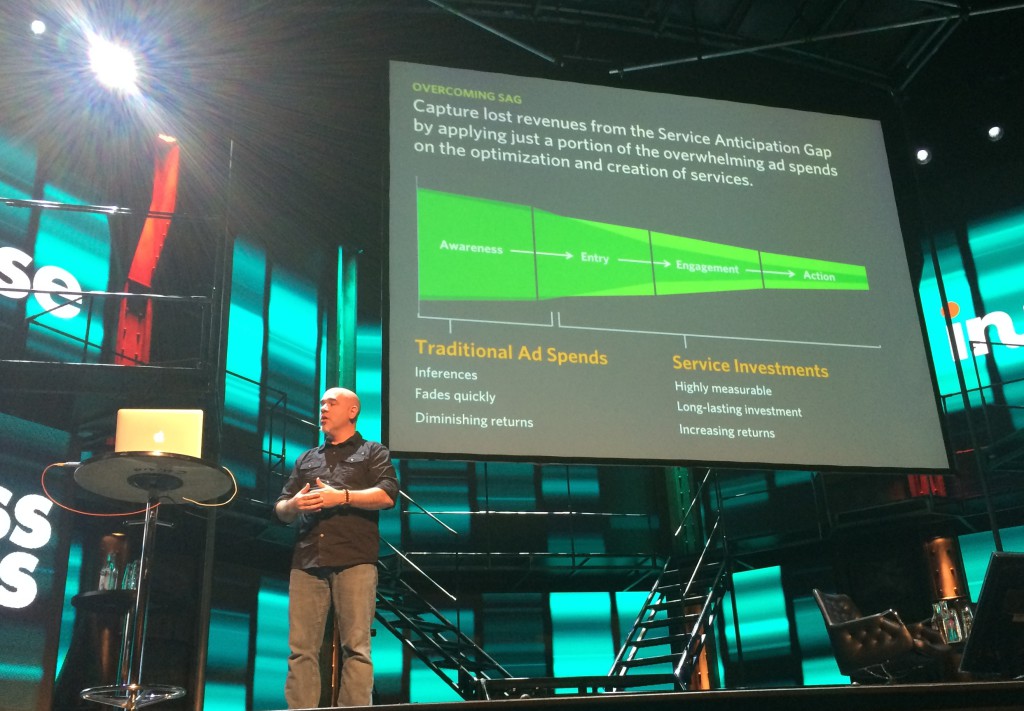A few of us visited the UX conference From Business to Buttons, organized by InUse, held here in Stockholm April 3rd. Here are my notes and a few reflections:
Finally, a UX-conference with great international speakers – in Stockholm!
- context drives design (don’t copy without thinking)
- cultural context should drive how we design
- project issues are symptoms and culture is the cause
- culture = connections, assumptions
- organizational values become the UX
- you can’t fake values (see United Airlines campaign)
- Question values -> Use the values -> Don’t be ruled by culture.
- Personas drives design, Culture values drive project plan
- Four types of organizations: Adhocracy, Clan, Hierarchy, Market
- prices in local store differs from website price = FAIL
- Service design for less tangible products: cross-chanel and multi-platform experience
- Empathy is the key to good design (read: Design thinking)
- Experience mapping: Journey -> Touchpoints -> Interaction -> Micro interactions
- Constraints and opportunities for each touchpoint
- Touchpoints can be Static (billboard), interactive (digital) or human (store)
- Touchpoint is NOT the channel, medium or platform
- Touchpoint IS “a point interaction for a specific user need in a specific time or place”
- Example: purchase groceries (not mobile grocery purchase)
- Understand your touchpoints: Describe, Characterize and Measure
- Last year, 40 billion USD spent on ads, 2 billion USD spent on designing of services
- Airbnb hired Pixar to animate 30 slides for all important user touchpoints
- every new idea has to aid a certain touchpoint for their users
- Empathy: to facilitate and share a value within a specific space
- Comics are great inspiration for stories
- Stories are includes shared pain, creation of heroes, punish, liberation
- Humans connect with emotions, not logic
- Designing without empathy leads to mechanic design
- Storytelling is a great artifact to evoke empathy in an organization
- Find your voice, may it be in text, visual drawings or coding
- Video of how Google used storytelling (Watch it!)
- Storytelling has a great impact on UX design in the US
- It is used in movies, games, news, entertainment etc.
- Think of Extreme House makeover or Oprah Winfrey…
- Big cultural gaps between generations
- Marriage is very important for relatives and parents
- They are active on dating sites to find spouse for their children
- Trust is very important in business relations
- Bright and cheerful colors are appreciated in visual design
- Remember this: spend time and effort in personal relations, respect seniors and learn Mandarin
- Chinese want to modernize – not westernize
- China have until recently copied most services and products out there
- Now it’s starting to change…
- 75% of all internet users connect via smartphone
- 71% via desktop
- Watch the clip “China at your fingertips”
- Yesterday’s assumptions don’t work in today’s reality
- Software is eating the world
- Fedex is not a logistic company, it’s software
- When you know what components to use for a product, assembly line production is good
- When you don’t know, assembly line sucks (i.e. waterfall)
- Software is continuous and never ending
- “How many features can we squeeze into the next version to bump the version number?”
- Roadmaps only gives false hope
- Roadmaps should consist of questions, not features
- There is misconception that new features always leads to better User Experience
- Feature is not a measure of success
- Again, feature is not NOT a measure of success…
- Read the article that gave birth to the Lean UX movement
- Core workshop: post its were improvements, not new features
- user feedback says “Improve” not “Renew”
- build product teams instead of project teams
- Cross-functional collaboration is the key for building product teams
- get rid of your fear of failure, embrace the approach of LEARNING…
- take small risks, learn and evaluate
Panel Discussion (video)
- “These kind of conferences are therapy for designers”
- Generative team = creating without purpose
- Collaborative team = creating with a common goal
- Asking the Why-question is challenging within an organization
- Expensive to have an 8-person Product team running
- Difficult to solve complex problems collaboratively
- Core team: PO, UX and Tech
The Ethical Designer (video)
- is capitalism ethical?
- are we using human weaknesses to gain money? (read: UX dark patterns)
- disruption – killing the middle man
- if you don’t buy the product, you ARE the product


